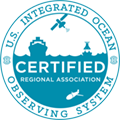Marine Debris
The March 2011 Japanese Tsunami is estimated to have swept about 5 million tons of debris into the ocean off the coast of Japan. Of that, it is expected that 70 percent of the debris sank, leaving 1.5 million tons floating in the Pacific Ocean. It is uncertain how much of that floating debris continues to float or has already washed ashore. The debris from the Japanese tsunami is not in a large mass but is scattered across the North Pacific in an area and some has already made its way to the beaches within the NANOOS region. Federal and local efforts are underway including conducting computer modeling, collecting at-sea observations, and monitoring U.S. West Coast beaches to assess and plan for the arrival of tsunami debris on West Coast beaches. Federal, state and local partners are working together to reduce possible impacts to our natural resources and coastal communities including mitigating any hazards to navigation, pollution and non-native species threats and impacts to safety or public health.

The 66-foot-long floating dock from Japan which washed ashore in Oregon more than a year after the 2011 tsunami. (Oregon Parks and Recreation Department)
Additional Resources
NOAA Marine Debris Program
Japan Tsunami Marine Debris
Pacific Northwest
State of Oregon
Related NANOOS Products
NANOOS Visualization System (NVS)
The NANOOS Visualization System (NVS) provides easy access to forecast and observation data across a wide range of assets such as buoys, shore and land stations, high-frequency radar, and satellites.
Ocean Currents
Daily average ocean surface currents off the Oregon coast. These surface currents are measured with a radio transmitter and receiver using an instrument, the SeaSonde, made by CODAR Ocean Sensors.
Nowcast/Forecast Coastal Currents
NANOOS Beach and Shoreline Mapping
Beach profiles provide important information concerning the temporal (time) and spatial (cross-shore) variability of the shape of a section of beach.
| National Observing System Partners Alliance for Coastal Technologies (ACT) Southeastern Universities Research Association (SURA) Integrated Ocean Observing System IOOS | |||||||

